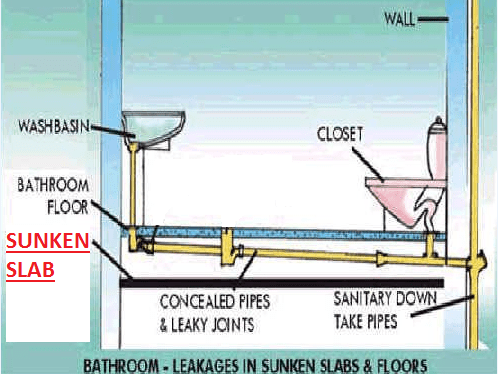Why sunken Slab is done in bathroom areas?
A sunken slab is done basically to conceal/hide drainage line and floor traps of a bath unit. The usual depth of sunken slab is 200 – 250 mm, in case of you want to have Eastern Water Closet (EWC), and 400 – 450 mm, in case you are going with orissa pan (IWC).

How to Avoid Sunken Slab?
To avoid a sunken slab you can adopt two methods:
1. Underslung Plumbing
2. Raised Toilet Flooring
1. underslung Plumbing
The toilet slab is built at the same level as the slabs adjacent to the toilet. Sleeves or Holes are punctured through the slab wherever plumbing pipes have to pass through, and the pipes is clamped to the bottom of the slab. It is concealed above a false ceiling from bottom of slab.
The false ceiling is provided with a door trap to make the plumbing lines accessible for maintenance. In this any leaks will drip onto the false ceiling and can be easily identified and repaired. If required, the entire plumbing can also be replaced without disturbing the structure (as in the case of sunken slab).
2. raised toilet Floor
In this the toilet slab is built at the same level as the slabs adjacent to the toilet. The toilet floor level is raised above the slab to conceal all plumbing line and fittings. Usually, a step is created from adjacent slab to enter the toilet unit.
Advantages and Disadvantages of Each System
Advantages and Disadvantages of Sunken Slab
Advantages of Sunken Slab
- All plumbing pipes are concealed inside the slab
- No Need special plumbing fixtures to reduce noise during usage of bathroom
Disadvantages of Sunken Slab
- Decrease in the height of the slab
- Slab, waterproofing and brick bat takes more time to construct as compared to Sunken Slab
Advantages and Disadvantages of Underslung Plumbing
Advantages of Underslung Plumbing
- Plumbing leakages can be repaired easily without any hassles
- Doesn’t include the cost of Brick bat coba etc., which usually acts as a filler materials in sunken slabs
Disadvantages of Underslung Plumbing
- Decreases the overall height of bathroom (from floor to ceiling)
- Need special acoustic pipe insulation or acoustic fittings to reduce the noise while bathroom is in use. This increases the costing of underslung plumbing
Advantages and Disadvantages of raised floor
Advantages of Raised Floor
- All plumbing pipes are concealed inside the slab
- No Need special plumbing fixtures to reduce noise during usage of bathroom
Disadvantages of raised Floor
- Decreases the height of bathroom and is unasthetic
- Inconvenient for elderly people to use
Happho’s Recommendation
We strongly recommend you to avoid the elevated or raised toilet floors in houses as they are unaesthetic and inconvenient.
You can take a judicious call between sunken slab and under-slung plumbing based on the pros and cons mentioned above.





